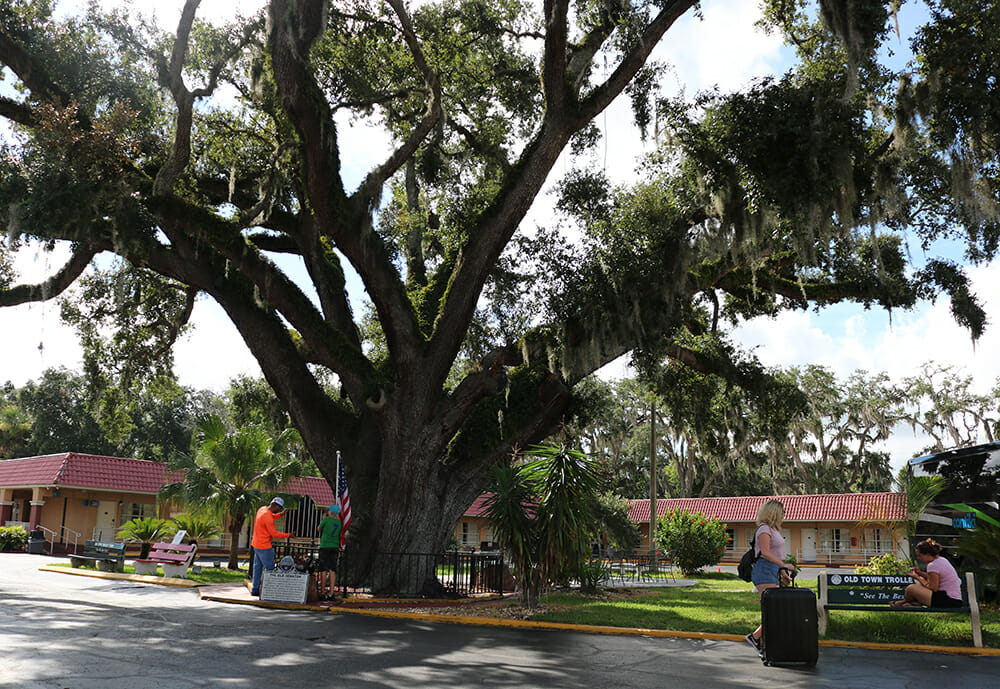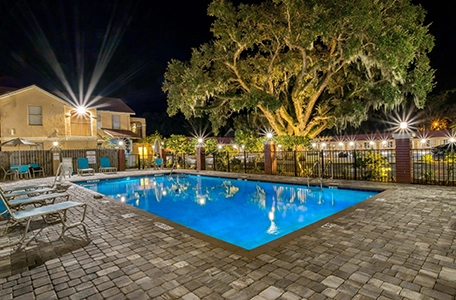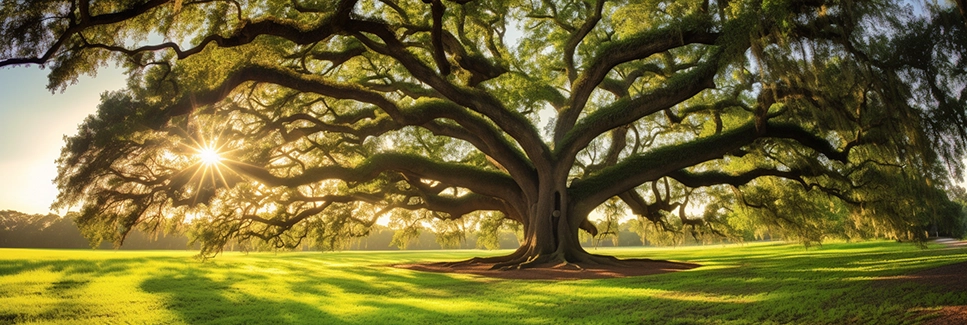
Oak Trees of Florida: Most Historic Giants
Our oldest oak trees of Florida hold the secrets of history, silent witnesses to the Sunshine State’s transformation over hundreds and maybe thousands of years.
These giants, with their sprawling branches reaching towards the sky and roots burrowing deep into the earth, have whispered tales of battles fought, plantations established, and civilizations that have flourished and faded.
Let’s explore some of Florida’s most historic live oaks and delve deeper into the fascinating world of these enduring symbols of the Sunshine State.
Coming up:
- How to Tell the Age of an Oak Tree
- Most Historic Oak Trees of Florida
- The Fairchild Oak – Ormond Beach
- The Old Senator – St. Augustine
- The Mammoth Live Oak – Fruitland Park
- The Tree of Tears – Jupiter
- The Treaty Oak – Gainesville
- The Devil’s Tree – Port Saint Lucie
- Wildlife Haven: Who Lives in these Old Oak Trees in Florida?
- Florida Oak Trees: Living Legends

How to Tell the Age of an Oak Tree
- Core Sampling Limitations: The most accurate method, core sampling, extracts a small core of wood from the center, revealing growth rings. However, this can injure the tree and isn’t ideal for very old or valuable specimens.
- Variable Growth Rates: Growth rates in oak trees depend on various factors like sunlight, water availability, and soil quality. A slow-growing oak in poor conditions might be older than a faster-growing one in ideal conditions, even if the latter has a larger trunk diameter.
- Trunk Diameter at Breast Height (DBH): A live oak with a DBH (diameter measured at 4.5 feet above the ground) of 10 feet or more could potentially be 300 years old or older.
Most Historic Oldest Oak Trees of Florida


The Fairchild Oak - Bulow Creek State Park in Ormond Beach
- Estimated Age: 400 to 2,500 years old
- Location: Ormond Beach, Florida
Considered the oldest oak tree in Florida, this massive live oak boasts a trunk circumference of nearly 30 feet. Standing sentinel within Bulow Creek State Park, it has likely witnessed centuries of Florida’s history.

The Old Senator - Villa 1565 Hotel, St. Augustine
- Estimated Age: 650 years old
- Location: St. Augustine, Florida
Nicknamed “The Old Senator,” this sprawling live oak graces the courtyard of the historic Villa 1565 Hotel. A silent observer of the city’s rich history for centuries, it’s estimated to be around 650 years old.
Note: a few years ago we stayed at Villa 1565 when they were finishing a major renovation. The newly-refurbished room was great, free breakfast was great, and the location is convenient. The St. Augustine trolley comes through a few times a day and points out The Old Senator oak tree in the middle of the property.
The tree is in an open central space and easy for anyone to go see. There’s a small plaque explaining it’s significance. If you’re considering a St. Augustine trip, we recommend Villa 1565 for a great budget-friendly stay.

The Mammoth Live Oak - Lake Griffin State Park
- Estimated Age: Between 300 and 500 years old
- Location: Fruitland Park, Florida
This giant Mammoth Live Oak in Lake Griffin State Park is the second-largest in the state and a beloved landmark at Lake Griffin State Park. Its sprawling branches and massive trunk whisper tales of Florida’s natural history, providing shade and shelter for generations of visitors and wildlife.



The Tree of Tears - Loxahatchee River Battlefield Park in Jupiter
- Estimated Age: 300 years old
- Location: Jupiter, Florida
Standing tall on an ancient burial mound believed to be a Seminole resting ground, the Tree of Tears stands as a poignant reminder of the Second Seminole War.
Designated a historical landmark, this roughly 300-year-old live oak embodies the struggles of the Seminole Tribe of Florida. Sadly, there is some current cause for concern as some think this mighty oak tree may be dying.
The Loxahatchee Battlefield Preservationists is a non-profit group dedicated to preserving the park where The Tree of Tears and other battle sites resides. They host tours and events throughout the year. Here’s the official Loxahatchee River Battleground Park website here.
Note: The Loxahatchee Battlefield Park is located INSIDE Riverbend Park.
Note: we went to an interesting lecture under the oaks at Riverbend Park which is the main park/entrance in Jupiter. After, we walked over (about 10 feet) to Loxahatchee Battlefield Park and joined a volunteer tour guide who showed us the Tree of Tears and other significant spots from The Second Seminole War (1835-1842).
See our blog on visiting Loxahatchee River Battlefield Park on the Treasure Coast of Florida, for more information about visiting the park, here.


The Treaty Oak - Jacksonville
- Estimated Age: Around 250 years old
- Location: Jacksonville, Florida
This live oak is believed to have witnessed the signing of a treaty between the U.S. government and local Seminole leaders in 1821.
The Treaty of Moultrie Creek, though ultimately unsuccessful in preventing the Second Seminole War, is a significant part of Florida’s history. See more history about The Treaty Oak and where to go visit it, here.

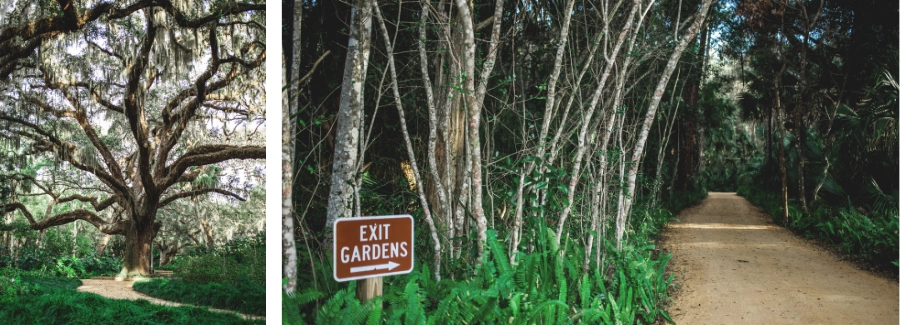
Washington Oaks Gardens State Park - Palm Coast
- Estimated Age of Oaks: 200-300 years old
- Location: Palm Coast, Florida in Flagler County
This 460-acre park features a captivating collection of live oaks, some estimated to be between 200 and 300 years old. While no documented historical events directly connect to specific trees, the park itself holds historical significance.
Originally a Timucuan village site, it became a plantation in the 1800s and now offers a glimpse into Florida’s past through its beautiful gardens and historic house.
Plan a visit to this beautiful park with the information on the official Washington Oaks Gardens State Park website here.

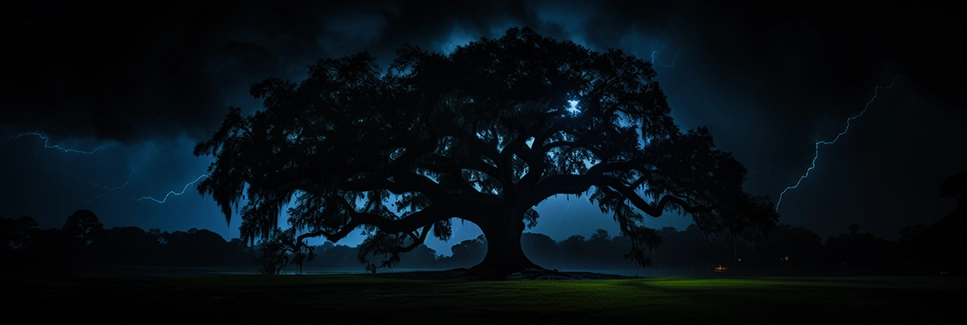
The Devil's Tree - Port Saint Lucie
- Location: Oak Hammock Park, Port Saint Lucie, Florida
Shrouded in local legend, The Devil’s Tree is a large live oak rumored to be a site of cult activity, paranormal occurrences, and even murders.
Stories claim multiple bodies were found near the tree in the 1970s and 90s, and some believe it’s a gateway to dark forces. The tree isn’t easy to find, and this park has a strict curfew to discourage nighttime visitors seeking thrills.
Read more on the Miami Haunts Devil Tree page about these haunted legends and get information on ghost tour opportunities around Florida!
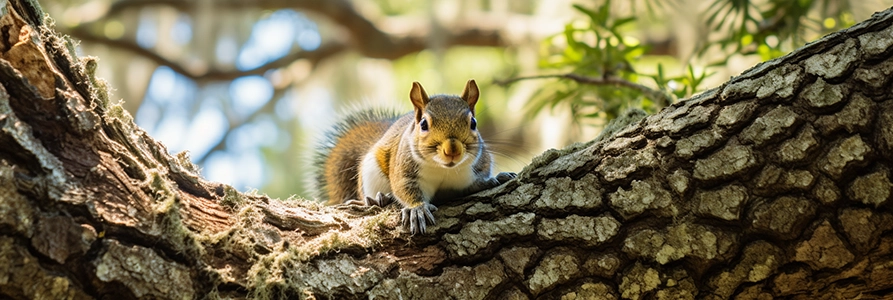
Wildlife Haven: Who Lives in these Old Oak Trees in Florida?
Florida’s old-growth oak trees are more than just majestic giants; they’re vital ecosystems teeming with life. Here’s a glimpse at some of the fascinating creatures that call these ancient wonders home:
- Birds: Woodpeckers, owls, hawks, eagles, and many songbirds find shelter, nesting sites, and a smorgasbord of insects in the nooks and crannies of old oaks.
- Mammals: Squirrels, bats, raccoons, and even bobcats may utilize the hollows and branches of these giants for shelter and raising young.
- Invertebrates: A multitude of insects, spiders, and other invertebrates find a haven within the bark, leaves, and decaying wood of old oaks.
- Amphibians: Tree frogs and other amphibians may cool off under the shade of the leaves and find moisture in the damp crevices of the bark.
The complex web of life within these ancient oaks highlights their importance to Florida’s biodiversity.
Florida's Oak Trees: Living Legends
These giants have witnessed the ebb and flow of civilizations, from Native American settlements to European colonization, the struggles of war, and the rise of modern Florida.
Imagine the whispers carried on the wind through their branches – whispers of ancient ceremonies, battles fought, treaties signed, and the quiet hum of nature persevering.
As we marvel at these living legends, let us remember the vital role they play in our ecosystem. These magnificent trees provide habitat for countless species, cleanse the air, and offer cool oases on hot Florida days.
The next time you stand beneath the shade of a majestic oak, take a moment to appreciate its silent presence. It is a reminder of the deep history that binds us to this unique and vibrant state, and a call to ensure its preservation for generations to come.
As an Amazon Associate I earn from qualifying purchases at no additional cost to you.

